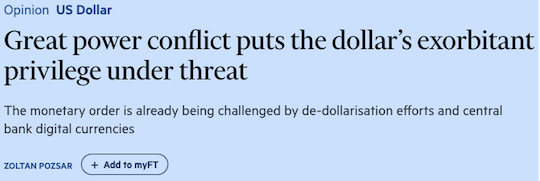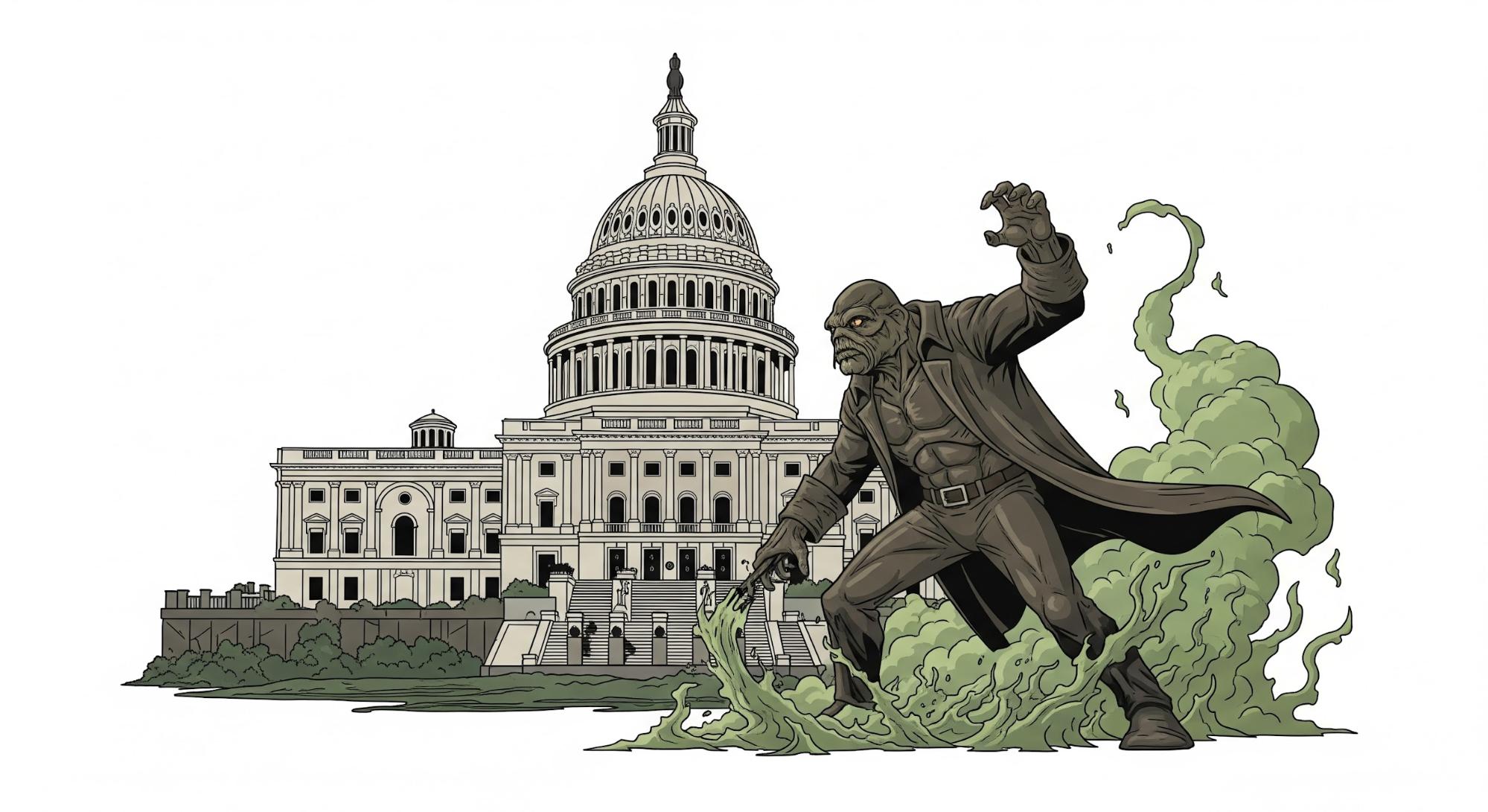Posted January 23, 2023
By Sean Ring
Beijing Bucks to Circumvent US System, Destroy USD’s “Exorbitant Privilege”
- It must be happening: the FT printed a piece on the threat to USD dominance.
- Zoltan Pozsar, Credit Suisse’s monetary guru, penned it.
- Pozsar looked specifically at two areas where the dollar is at a disadvantage.
Good morning from cloudy, cold Piedmont.
I hope you had a wonderful, restful weekend.
I got back on the prosecco and imbibed a few beers but didn’t do anything too exciting otherwise.
As I was thumbing through my phone, I found a Telegram message from Gonzalo Lira that read:
The Financial Times ran an excellent op-ed this morning discussing the decline of the USD and the emergence of a multipolar world. It’s getting harder to ignore.
This picture accompanied the message:

Credit: The Financial Times
I’m acquainted with Gonzalo through mutual friends. He and Pepe Escobar are the multipolar world’s leading cheerleaders.
So, the message didn’t surprise me.
What surprised me was that the piece was printed in the FT. The “Pinko” Paper is as euro trash left as you can get, especially with its stable of British “Remoaner” writers.
But a second thing softened the surprise. The column’s author is Zoltan Pozsar.
Zoltan Pozsar works for Credit Suisse as an investment strategist in New York. To say his CV is impressive understates his incredible knowledge of the Federal Reserve’s plumbing system.
Here’s his Credit Suisse bio blurb (bolds mine):
Prior to joining Credit Suisse in February 2015, Mr. Pozsar was a senior adviser to the US Department of the Treasury, where he advised the Office of Debt Management and the Office of Financial Research, and served as the Treasury’s liaison to the FSB on matters of financial innovation. Mr. Pozsar was deeply involved in the response to the global financial crisis and the ensuing policy debate.
He joined the Federal Reserve Bank of New York in August 2008 in charge of market intelligence for securitized credit markets and served as point person on market developments for senior Federal Reserve, US Treasury and White House officials throughout the crisis; played an instrumental role in building the TALF to backstop the ABS market; and pioneered the mapping of the shadow banking system which inspired the FSB’s effort to monitor and regulate shadow banking globally.
Later at the IMF he was involved in framing the Fund’s official position on shadow banking and consulted G-20 working groups. He consulted G-7 policymakers, central banks and finance ministries on global macro-financial developments.
Pozsar is the most listened-to pundit on Wall Street these days vis-à-vis monetary matters, with expertise unmatched by any in the financial space.
So, when he writes stuff like this, it’s not only worth reading. It’s self-evidently essential.
But first, let’s review some of the reasons investors have been calling time on dollar dominance.
Reasons For the Dollar’s Demise
The US dollar has been the dominant global reserve currency since the end of World War II, but there are several reasons pundits have claimed it may lose its place soon.
The Growing Power of China, India, Europe, and the Global South
One reason is the growing economic power of other countries, particularly China. As China's economy continues to grow and become more integrated with the global economy, the renminbi is becoming a more attractive alternative to the dollar as a reserve currency.
Additionally, the increasing use of the euro as a reserve currency may contribute to shifting away from the dollar.
This reason is rapidly losing its luster as China’s population shrinks and its economy assumes “normal” levels of growth. The euro doesn’t have the monetary stability needed, nor does the eurozone have a unified fiscal policy. India and the Global South aren’t developed enough yet.
US Economic and Political Instability
Another reason is the increasing concern over the long-term stability of the US economy. The ongoing trade and budget deficits, as well as the growing national debt, have led to concerns over the ability of the US to maintain its economic dominance in the long-term.
The US's monetary policy and the Federal Reserve's actions also impact the dollar's status. The Federal Reserve's use of quantitative easing and other unconventional monetary policies have led to concerns over inflation and currency devaluation.
The above may seem appalling to most onlookers, but it hasn’t been enough to get most to shift out of dollars.
But here are two reasons that Pozsar states are currently - right now - making the dollar’s “exorbitant privilege” vulnerable.
De-dollarization. The US's political instability and propensity to engage in foreign conflicts raise doubts about its ability to maintain a stable and predictable foreign policy. The more unstable and trigger-happy the USG, the quicker others find alternatives to the dollar.
Central Bank Digital Currencies. The shift towards digital currencies and the emergence of innovative technologies such as blockchain could also have an impact on the dollar's status as a global reserve currency. As these technologies become more widely adopted and accepted, they may provide an alternative to traditional fiat currencies like the dollar.
Plainly put, if you think Biden Bucks are bad, get a load of Beijing Bucks!
Biden Bucks Are Bad Enough. Beijing Bucks Are Worse!
This is what Pozsar had to say about CBDCs in the FT:
CBDCs could accelerate this transition. China has changed the strategy through which it internationalizes the renminbi. Given that financial sanctions are implemented through the balance sheets of western banks, and that these institutions form the backbone of the correspondent banking system that underpins the dollar, using the same network to internationalize the renminbi may have come with risks. To get around this, a new network was needed.
Around the world but particularly in the global east and south, CBDCs are spreading like fast-growing kudzu vines with more than half of the world’s central banks exploring or developing digital currencies with pilots or research, according to the IMF. They will be increasingly interlinked. Central banks interlinked through CBDCs essentially recreate the network of correspondent banks that the US dollar system runs on — instead of correspondent banks, think more of correspondent central banks. The emerging, CBDC-based network — enforced with bilateral currency swap lines — could enable central banks in the global east and south to serve as foreign exchange dealers to intermediate currency flows between local banking systems, all without referencing the dollar or touching the western banking system.
Pozsar is telling us the Chinese have built a parallel system that evades the dollar entirely. So, these Beijing Bucks are CBDCs between central banks, not bank-to-customer.
The result could be far worse for the dollar system than previously imagined.
If foreign entities can trade with other countries safely without using the USD, why would they buy the USD? The dollar loses its underlying natural bid.
Pozsar concludes his piece with this:
If less trade is invoiced in US dollars and there is a dwindling recycling of dollar surpluses into traditional reserve assets such as Treasuries, the “exorbitant privilege” that the dollar holds as the international reserve currency could be under assault.
Wrap Up
Those wily Chinese government officials knew that the renminbi's internationalization would be risky if it was done the old-fashioned way.
So, they created a new way to internationalize the renminbi by bypassing the western banking system.
As a result, the dollar is vulnerable to outflows in its systems, as China and its allies in the Global South will use Beijing Bucks and swap lines to evade the dollar altogether.
The West’s number one monetary analyst thinks this is coming. So now it’s time to start thinking about defense.
Until tomorrow.

How FDR Put America Behind Golden Bars
Posted December 12, 2025
By Byron King

Swamp Thing
Posted December 11, 2025
By Sean Ring

A Sliver of Silver
Posted December 10, 2025
By Sean Ring

The Public Service of Pushing Brains Into Industry
Posted December 09, 2025
By Sean Ring

Did America Just Lose The Great Game?
Posted December 08, 2025
By Sean Ring

